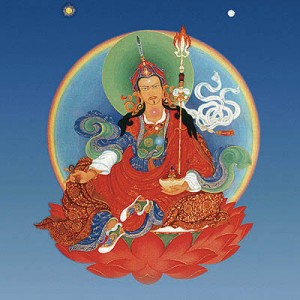
“The youthful infant, Padmasambhava, manifesting on a lotus, is exactly the nature of our mind. Our mind may be born in the muddy lake of samsara, and the lotus may be born in this muddy lake of samsara, but the lotus itself is completely free from any dust. It remains beautiful, full of color and freshness.” –The Dzogchen Ponlop Rinpoche
From Bodhi: Journey to Awakening and the article “Life and Teachings Of Guru Padmasambhava” by The Dzogchen Ponlop Rinpoche. (See full article below)
When people ask me “what is the optimal state of mind for creativity?” it is sometimes difficult to give them an answer without sounding crazy; it seems to arrive like some garbled transmission arriving from deep space. The answer, though, is short: creativity is the natural state of mind.
When we are who we are, without embellishment, elaboration, or embarrassment, our lives unfold as a natural expression of creativity. We don’t stop to think, “Well if I just get through this annoying task, then I can start to be creative, then I can start living my real life.” No! Not at all. A creative life, as Ponlop Rinpoche expresses so beautifully in his article, arises from the clarity of mind that is always already available. The lotus, a beautiful flower that grows from mud and muck of a pond, symbolizes the muck and messiness of our everyday lives, and also the potential for creativity that is always already available, so long as we hold all things as sacred.
In Tibetan Vajrayana Buddhism, Padmasambhava, known also as “The Lotus Born,” is the archetypal representation of that quality of mind that is naturally creative. And it isn’t just his mind that is creative. All our minds are naturally creative. All our minds are tuned to connect to the world deeply and to affect the world in a meaningful way. This is the heart of creativity and this is also the heart of what it means to be human.
Creativity, as expressed by Padmasambhava, is born of 1) wisdom awareness (seeing the world clearly) and 2) the union of bliss and emptiness (the enjoyment obtained by experiencing and participating in the interdependent nature of the universe). Does this seem like a tall order? Absolutely not. At the heart of you and everyone else is this basic, incredibly intimate relationship with the world. Drop into it and delight us with the creative gifts that you have to bring!
Life and Teachings Of Guru Padmasambhava by The Dzogchen Ponlop Rinpoche:
When the King of Uddiyana found the Lotus-Born in the middle of Dhanakosha Lake, he asked these questions of Padmasambhava: “Wondrous youthful Son of the Lotus, who is your father? Who is your mother?” and, “To which country do you belong?” Because they were on the Indian continent, he asked, “To which caste do you belong?” Since Padmasambhava manifested in the form of an eight-year old, the king also asked the question, “What food have you been eating?” Padmasambhava answered, “My father is the wisdom of awareness, and my mother is Samantabhadri, which is the union of bliss and emptiness.” He then said, “The country of my citizenship is the unborn dharmadhatu. I belong to the caste of inseparable space and awareness, and the food that sustains me is the food of duality.” Now we know his parents, what he has been eating to sustain his activity of conquering emotions, and the country of his citizenship. It is not so outrageous. It seems quite normal. We have a father, we have a mother, and we have a country of citizenship.
In this youthful infant on a lotus, there was a sense of freshness, of fresh breath, in the very nature of his manifestation. He was full of inquisitive mind, and completely free of any fear of touching anything. This seems to be the nature of our awakened mind, the childlike aspect of our mind, which is also infant-like and completely in the nature of primordial freshness. There is a sense of total freedom from fear, complete space, and complete fearlessness about touching anything.”
For the full article, go here.